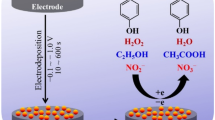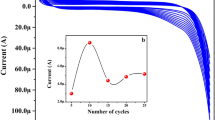Abstract
A glassy carbon electrode was modified with a TiO2-gold nanoparticle hybrid integrated with multi-walled carbon nanotubes in a dihexadecylphosphate film (TiO2-Au NP-MWCNT-DHP/GCE) and applied to amperometric determination of ascorbic acid (AA). The modified sensor displays fast charge transfer and shows an irreversible anodic behavior for AA by cyclic voltammetry. Under optimal experimental conditions and using amperometry at 0.4 V, the analytical curve presented a statistical linear concentration range for AA from 5.0 to 51 μmol L−1, with a limit of detection of 1.2 μmol L−1. The electrode was successfully applied to the determination of AA in pharmaceutical and fruit juice without the need for major pretreatment of samples.

Schematic of a new sensing platform for ascorbic acid (AA). It is based on a glassy carbon electrode (GCE) modified with TiO2-Au nanoparticles integrated into carbon nanotubes in a dihexadecylphosphate film. The sensor was applied to amperometric determination of AA in juice and pharmaceutical samples.





Similar content being viewed by others
References
Marsanasco M, Calabró V, Piotrkowski B, Chiaramoni NS, del V. Alonso S (2016) Fortification of chocolate milk with omega-3, omega-6, and vitamins E and C by using liposomes. Eur J Lipid Sci Technol 118:1271–1281. https://doi.org/10.1002/ejlt.201400663
Varvara M, Bozzo G, Disanto C, et al (2016) The use of the ascorbic acid as food additive and technical-legal issues. Ital J Food Saf 5.https://doi.org/10.4081/ijfs.2016.4313
Radovan C, Cofan C, Cinghita D (2008) Simultaneous determination of acetaminophen and ascorbic acid at an unmodified boron-doped diamond electrode by differential pulse voltammetry in buffered media. Electroanalysis 20:1346–1353. https://doi.org/10.1002/elan.200804188
Ngai KS, Tan WT, Zainal Z et al (2013) Voltammetry detection of ascorbic acid at glassy carbon electrode modified by single-walled carbon nanotube/zinc oxide. Int J Electrochem Sci 8:10557–10567
Fernandes DM, Silva N, Pereira C, Moura C, Magalhães JMCS, Bachiller-Baeza B, Rodríguez-Ramos I, Guerrero-Ruiz A, Delerue-Matos C, Freire C (2015) MnFe2O4@CNT-N as novel electrochemical nanosensor for determination of caffeine, acetaminophen and ascorbic acid. Sensors Actuators B Chem 218:128–136. https://doi.org/10.1016/j.snb.2015.05.003
Kannan P, John SA (2009) Determination of nanomolar uric and ascorbic acids using enlarged gold nanoparticles modified electrode. Anal Biochem 386:65–72. https://doi.org/10.1016/j.ab.2008.11.043
Hosseini MG, Faraji M, Momeni MM (2011) Application of titanium oxide nanotube films containing gold nanoparticles for the electroanalytical determination of ascorbic acid. Thin Solid Films 519:3457–3461. https://doi.org/10.1016/j.tsf.2010.12.239
Aneesh PK, Nambiar SR, Rao TP, Ajayaghosh A (2014) Electrochemically synthesized partially reduced graphene oxide modified glassy carbon electrode for individual and simultaneous voltammetric determination of ascorbic acid, dopamine and uric acid. Anal Methods 6:5322–5330. https://doi.org/10.1039/c4ay00043a
Taleb M, Ivanov R, Bereznev S, Kazemi SH, Hussainova I (2017) Ultra-sensitive voltammetric simultaneous determination of dopamine, uric acid and ascorbic acid based on a graphene-coated alumina electrode. Microchim Acta 184:4603–4610. https://doi.org/10.1007/s00604-017-2510-y
Zhao D, Fan D, Wang J, Xu C (2015) Hierarchical nanoporous platinum-copper alloy for simultaneous electrochemical determination of ascorbic acid, dopamine, and uric acid. Microchim Acta 182:1345–1352. https://doi.org/10.1007/s00604-015-1450-7
Parola S, Julián-López B, Carlos LD, Sanchez C (2016) Optical properties of hybrid organic-inorganic materials and their applications. Adv Funct Mater 26:6506–6544. https://doi.org/10.1002/adfm.201602730
Eder D (2010) Carbon nanotube−inorganic hybrids. Chem Rev 110:1348–1385. https://doi.org/10.1021/cr800433k
Cho ES, Coates NE, Forster JD, Ruminski AM, Russ B, Sahu A, Su NC, Yang F, Urban JJ (2015) Engineering synergy: energy and mass transport in hybrid nanomaterials. Adv Mater 27:5744–5752. https://doi.org/10.1002/adma.201500130
Kaur B, Srivastava R (2015) Simultaneous determination of epinephrine, paracetamol, and folic acid using transition metal ion-exchanged polyaniline–zeolite organic–inorganic hybrid materials. Sensors Actuators B Chem 211:476–488. https://doi.org/10.1016/j.snb.2015.01.081
Sarhangzadeh K (2015) Application of multi wall carbon nanotube–graphene hybrid for voltammetric determination of naproxen. J Iran Chem Soc 12:2133–2140. https://doi.org/10.1007/s13738-015-0690-0
Matthews FL, Rawlings RD (2008) Composite materials: engineering and science. CRC Press
Welch CM, Compton RG (2006) The use of nanoparticles in electroanalysis: a review. Anal Bioanal Chem 384:601–619. https://doi.org/10.1007/s00216-005-0230-3
Jiang K, Eitan A, Schadler LS, Ajayan PM, Siegel RW, Grobert N, Mayne M, Reyes-Reyes M, Terrones H, Terrones M (2003) Selective attachment of gold nanoparticles to nitrogen-doped carbon nanotubes. Nano 3:275–277. https://doi.org/10.1021/NL025914T
Kim B, Sigmund WM (2004) Functionalized multiwall carbon nanotube/gold nanoparticle composites. Langmuir 20:8239–8242. https://doi.org/10.1021/LA049424N
Xu C, Chen J, Cui Y, Han Q, Choo H, Liaw PK, Wu D (2006) Influence of the surface treatment on the deposition of platinum nanoparticles on the carbon nanotubes. Adv Eng Mater 8:73–77. https://doi.org/10.1002/adem.200500179
Zhou L, Ziong W, Liu S (2015) Preparation of a gold electrode modified with au–TiO2 nanoparticles as an electrochemical sensor for the detection of mercury(II) ions. J Mater Sicence 50:769–776. https://doi.org/10.1007/s10853-014-8636-y
Ampelli C, Leonardi SG, Genovese C, Lanzafame P, Perathoner S, Centi G, Neri G (2015) Monitoring of glucose in fermentation processes by using au/TiO2 composites as novel modified electrodes. J Appl Electrochem 45:943–951
Damato TC, de Oliveira CCS, Ando RA, Camargo PHC (2013) A facile approach to TiO2 colloidal spheres decorated with au nanoparticles displaying well-defined sizes and uniform dispersion. Langmuir 29:1642–1649. https://doi.org/10.1021/la3045219
dos Reis FVE, Antonin VS, Hammer P, Santos MC, Camargo PHC (2015) Carbon-supported TiO2–au hybrids as catalysts for the electrogeneration of hydrogen peroxide: investigating the effect of TiO2 shape. J Catal 326:100–106. https://doi.org/10.1016/j.jcat.2015.04.007
British Pharmacopoeia Commission (2013) British pharmacopoeia, 5th ed. The Stationery Office, London
Sartori ER, Vicentini FC, Fatibello-Filho O (2011) Indirect determination of sulfite using a polyphenol oxidase biosensor based on a glassy carbon electrode modified with multi-walled carbon nanotubes and gold nanoparticles within a poly(allylamine hydrochloride) film. Talanta 87:235–242. https://doi.org/10.1016/j.talanta.2011.10.003
Ardila JA, Oliveira GG, Medeiros RA, Fatibello-Filho O (2013) Determination of gemfibrozil in pharmaceutical and urine samples by square-wave adsorptive stripping voltammetry using a glassy carbon electrode modified with multi-walled carbon nanotubes within a dihexadecyl hydrogen phosphate film. J Electroanal Chem 690:32–37. https://doi.org/10.1016/J.JELECHEM.2012.11.038
Al-Otaify A, Leontiadou MA, dos Reis FVE et al (2014) Size dependence of ultrafast charge dynamics in monodisperse au nanoparticles supported on TiO2 colloidal spheres. Phys Chem Chem Phys 16:14189–14194. https://doi.org/10.1039/c4cp01475h
Janegitz BC, Baccarin M, Raymundo-Pereira PA, dos Santos FA, Oliveira GG, Machado SAS, Lanza MRV, Fatibello-Filho O, Zucolotto V (2015) The use of dihexadecylphosphate in sensing and biosensing. Sensors Actuators B Chem 220:805–813. https://doi.org/10.1016/j.snb.2015.06.020
Suresh S, Gupta M, Kumar GA, Rao VK, Kumar O, Ghosal P (2012) Synergic effect of multi-walled carbon nanotubes and gold nanoparticles towards immunosensing of ricin with carbon nanotube–gold nanoparticles–chitosan modified screen printed electrode. Analyst 137:4086–4092. https://doi.org/10.1039/c2an35279f
Gosser DK (1993) Cyclic voltammetry: simulation and analysis of reaction mechanisms. John Wiley & Sons, Inc., New York
Bard AJ, Faulkner LR (2001) Electrochemical methods : fundamentals and applications, 2nd edn. John Wiley & Sons, New York
Lvovich VF (2012) Impedance spectroscopy: applications to electrochemical and dielectric phenomena. John Wiley & Sons, Inc., Hoboken
Yilmaz S, Sadikoglu M, Saglikoglu G et al (2008) Determination of ascorbic acid in tablet dosage forms and some fruit juices by DPV. Int J Electrochem Sci 3:1534–1542
Miller JM, Miller JC (2010) Statistics and Chemometrics for analytical chemistry, 6th edn. Pearson, Harlow
Acknowledgements
The authors gratefully acknowledge financial support and scholarships from the funding agencies Coordenação de Aperfeiçoamento de Pessoal de Nível Superior (CAPES), Conselho Nacional de Desenvolvimento Científico e Tecnológico (CNPq), Fundação de Amparo à Pesquisa do Estado de São Paulo (FAPESP; Grant numbers 2015/21366-9 and 2015/11452-5) and Fundação Araucária do Paraná. Special thanks to Juliane Cristina Leme for her kind help in statistical analyses.
Author information
Authors and Affiliations
Corresponding author
Ethics declarations
The authors declare that they have no competing interests.
Electronic supplementary material
ESM 1
(DOCX 310 kb)
Rights and permissions
About this article
Cite this article
Scremin, J., Barbosa, E.C.M., Salamanca-Neto, C.A.R. et al. Amperometric determination of ascorbic acid with a glassy carbon electrode modified with TiO2-gold nanoparticles integrated into carbon nanotubes. Microchim Acta 185, 251 (2018). https://doi.org/10.1007/s00604-018-2785-7
Received:
Accepted:
Published:
DOI: https://doi.org/10.1007/s00604-018-2785-7




